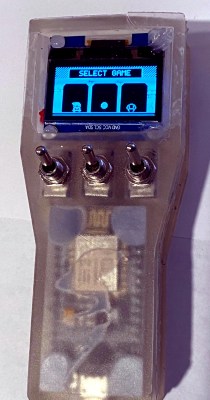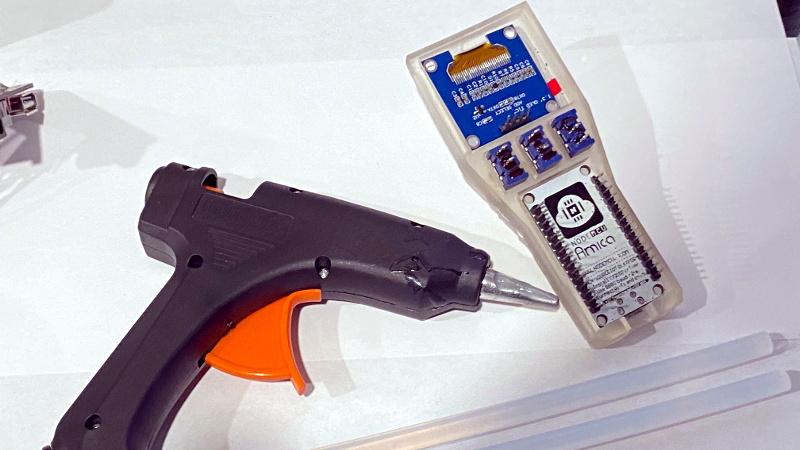Teacher says that every time a toggle switch clunks, a hacker gets their wings. Or something like that. All we know is that there are few things the hardware tinkerer likes more than the satisfying action of a nice flip. Which by extension means this handheld game built by [Roman Revzin] and controlled by nothing more than three toggle switches will likely be a big hit at the hackerspace.
 The parts list for this game, which [Roman] calls the ToggleBoss, is about as short as it gets. There’s a NodeMCU ESP8266 development board, a common SH1106 OLED display, and a trio of suitably clunky toggle switches. Add a bit of wire, toss it all into a 3D printed enclosure, and you’re halfway to thumb flicking nirvana.
The parts list for this game, which [Roman] calls the ToggleBoss, is about as short as it gets. There’s a NodeMCU ESP8266 development board, a common SH1106 OLED display, and a trio of suitably clunky toggle switches. Add a bit of wire, toss it all into a 3D printed enclosure, and you’re halfway to thumb flicking nirvana.
Naturally, you might be wondering about the sort of games that can be played with three latching digital inputs; after all, it’s not exactly the most conventional controller layout. But there is where ToggleBoss really shines. Instead of trying to shoehorn traditional games into an exceptionally unconventional system, [Roman] has come up with several games which really embrace the limited input offered to the user.
In a platforming game not unlike the classic Mario Bros, the positions of the physical switches are mapped to virtual walls that are raised and lowered to control a character’s movement through the level. Another game shows the player three dots which correspond to the intended switch states, which they have to match as quickly and as accurately as possible. [Roman] has released the source code to his current lineup of games, which hopefully will inspire others to try their hand at creating software for this fascinating little system.
With the availability of cheap OLED displays and powerful microcontrollers, we’ve started to see more of these bespoke gaming systems. While some will undoubtedly prefer a pocket full of Nintendo’s classics, we think there’s something special about a game system that you can truly call your own.
















Correct me if I’m wrong (Okay, that’s total redundancy here, gah, so is this.) but aren’t toggle switches the ORIGINAL way to play computer video games, Spacewar I’m thinking…
Also back in the postwar era, multichannel radio control used to be one action per channel* on and off, and the Transmitter boxes would be bristling with toggles, which the pilot would have to modulate manually if he wanted to perform delicate maneuvering.
*Okay they called it channels when it wasn’t actually radio channels, the TX was ON a particular channel, but the individual functions were also called channels. Really they were audio channels on top of the carrier, AM, 7 different tones was I think the most practical, usually discriminated with vibrating reeds, like electromechanical tuning forks.
Space War used regular pushbuttons, and quite a lot of them. An arcade in suburban New Orleans had an original machine until nearly 1990 and I played it often against one of my fellow high school alumnae.
Not that Space War.
IDK if I was going off a poorly remembered description in “Hackers” or what, but they seem a tad less toggly than I thought they were… https://tomtilley.net/projects/spacewar/
> audio channels on top of the carrier
Depending on which war you mean by postwar, that seems to have stuck for quite some time. In the 80s, another kid (my cousin IIRC) showed me that you could activate a 49mHz Radio Hack car using 49mHz walkie-talkies. Forward and back on the drive stick would make a high or low tone in your ear, so if you made roughly-matching high and low tones with your voice, you could “drive” but not steer. The steering was encoded some way that I could barely hear, but I never reproduced it or figured it out or even went and read about it… not sufficiently curious :(
Now that you bring it up it becomes clear: probably it was just another pair of tones and nothing so mysterious as I imagined from them being so subtle. I do remember being able to tell left and right apart, but they were high enough that either my ears’ or the radios’ limitations filtered out almost all of it. I had no means to reproduce them, in any case. DTMF? Overtone singing, right!
Steering was possibly pulse proportional. Varying mark/space ratio.
Adorable. I love tiny consoles with tactile inputs, and this is so creative!
I once taped one of those monochrome OLEDs and a postage-stamp MCU to a 9V battery and plugged two rotary encoders into it for Pong on the go.
Tetris is another good one, but it might be hard to come up with a control scheme that uses 3 toggle switches…
I already have a match 3 game in the repo, feel free to add! :)
I’ve included a match 3 game that’s loosely based on sega’s columns, you can toggle states of the pieces falling down to try to match 4x plus.
Roman, would you make video please?
https://www.reddit.com/r/arduino/comments/fgqlkg/i_love_toggles_and_built_this_game_handheld_that/
Here you go.
Roman, kudos to you. I was waiting a long time since I saw something fresh and original as this. Keep up good work :) Where can I follow you?
I haven’t set anything up yet, but I will lol.